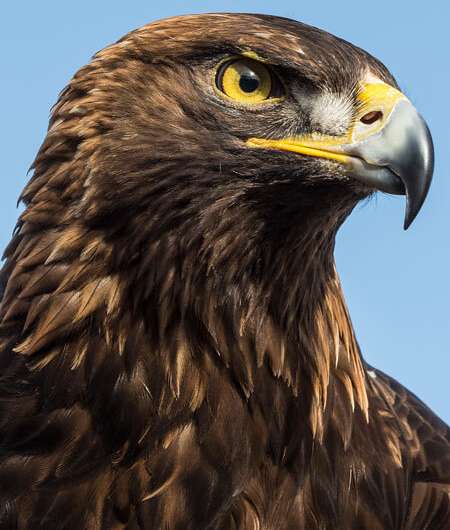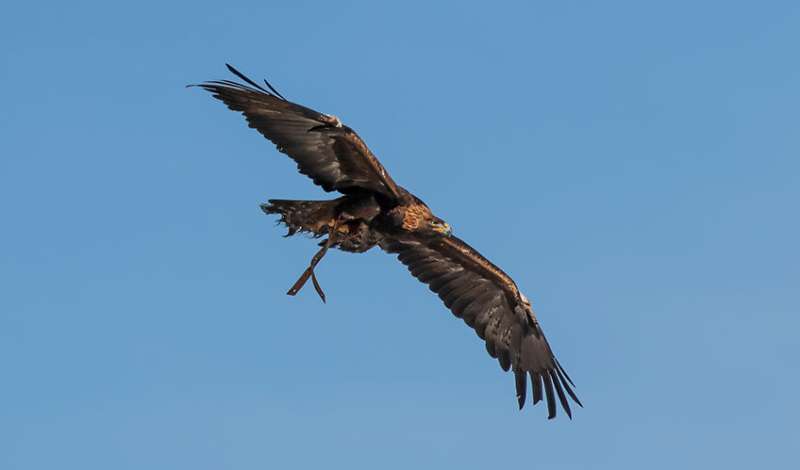The wind energy industry has investigated various strategies and technologies that can help protect golden eagles like the one shown here, such as installing tools like IdentiFlight in wind plants. However, understanding eagle flight behavior to predict how these animals move in and around a wind power plant remains challenging. Credit: Dennis Schroeder, NREL
Golden eagles strike a cutting visage that, to put it mildly, grants the species an aura of regality. Occupying much of the Northern Hemisphere, many cultures view this species as a sacred messenger of the gods and kings and queens of the sky.
Not only are these birds highly revered, but highly protected—receiving protections under the Bald and Golden Eagle Protection Act and the Migratory Bird Treaty Act. As a result, their presence must be carefully considered by wind power plant operators and developers working in eagle territory, presenting challenges that can extend permitting timelines, add unanticipated project costs, and constrain energy output.
To address these challenges, National Renewable Energy Laboratory (NREL) scientists along with fellow researchers at the U.S. Geological Survey, Western EcoSystems Inc., and Conservation Science Global Inc. are developing a state-of-the-art computational framework for modeling golden eagle behavior near wind farms. In all hopes, this tool can help guide wind power plant siting decisions and dynamic curtailment strategies informed by real-time eagle flight path prediction.
Invisible Currents of Influence
As soaring birds, golden eagles rely on atmospheric updrafts to glide across the sky without flapping their wings. However, existing models to predict eagle flight behavior do not fully consider all the atmospheric conditions at play that can influence flight paths eagles choose in an area with different atmospheric conditions (i.e., during different seasons or times of day).
"Existing models to understand eagle soaring behavior focus on orographic updrafts—natural phenomena when an air mass moves from low terrain to high terrain forcing air upward," said Eliot Quon, who leads the eagle modeling project at NREL. "This derives from golden eagle preference for flying near windward slopes and along ridgelines, but it's an incomplete picture. Our model updates existing behavior models by bringing in some of those unconsidered atmospheric conditions combined with the uncertainty of realistic eagle behaviors."
As an example of some of these unconsidered atmospheric conditions, biologists have observed that golden eagles more regularly deviate from ridges during late spring and summer. They do so to take advantage of thermal currents that mix with orographic lift along ridge lines and cliffs. It is in these conditions that eagles may be more likely to come into conflict with wind turbines, especially while changing flight modes, but existing eagle behavioral modeling does not take both conditions into account.
To account for this atmospheric mixing, the NREL team brought together atmospheric scientists and wind plant aerodynamics researchers from the Department of Energy's Mesoscale-to-Microscale Coupling project to work with data scientists and biologists. They have been tasked with incorporating multiscale atmospheric modeling that combines and captures conditions of an area—thermals, orographic lift from mountainous terrain, and other forms of turbulence (like the wakes of wind turbines)—into a single model to get a more holistic view of wind flow at a power plant. With this high-resolution information, they can show the frequency, location, and strength of various atmospheric features in an area that, paired with regional weather and eagle flight behavior data, can help provide wind developers with a predictive, probabilistic model of how and where an eagle will fly.
Paired with other tools and analyses, information from this computational framework can be fed into wind power plant controls to help predict bird flight paths, helping operators make better-informed curtailment decisions. Simulations of eagle behavior at a prospective wind site can also help to improve future project siting efforts.
Thermals—pillar-like atmospheric structures that push air upward as a result of surface heating of the earth by the sun—and orographic uplift are two conditions eagles take advantage of in flight. Eagles can spiral upward several kilometers when they find a thermal, which is well above even the tallest wind turbines. Credit: Dennis Schroeder, NREL
Building a Better Model
At this stage, the team has focused their atmospheric modeling for a specified region in the United States and has begun validating the behavioral component of the computational framework with eagle telemetry data that represent eagle flight patterns collected by Conservation Science Global and the U.S. Geological Survey. And it is this comparison between modeled and observed behaviors that will help the team isolate variables that influence eagle movement that may not be identifiable without insights into atmospheric influences being incorporated.
While the current work considers longer-range migratory movements, the behavioral model will be further augmented with new telemetry data provided by IdentiFlight stereo camera systems, which the team believes can provide crucial insights into near-turbine flight behaviors within a kilometer of a wind plant.
"Our approach can help us better understand the known unknowns and identify unknown unknowns," Quon said. "The outlier cases identified by the model can help identify variables that create risk—be those shifts in wind direction, prey, or other drivers."
When discussing the team's computational framework for modeling golden eagle behavior, Quon is quick to point out that it does not predict risk per se but can help analysts consider a suite of variables that can inform risk analysis. In this way, the model helps analysts infer risk to eagles at a specified wind power plant and assess prior analysis performed at the site.
Model Availability, Future Developments, and a Spring for Conservation
The project team is currently working to distill relevant information about local atmospheric conditions from extremely detailed, high-fidelity simulations run on supercomputers. By improving the representation of weather in the eagle computational framework, the team believes it can better characterize eagle flight environments, improving the machine-learning component of the eagle computational framework that assesses eagle flight behavior.
"Of course, not everyone has a high-performance computer like Eagle to simulate high-resolution atmospheric conditions in an area," Quon said. "However, the model we provide will allow users to run eagle flight simulations on most laptops; it just so happens to come prepackaged with knowledge built on the powerful computing capabilities of a national lab. Insights from the data we've gathered should go a long way in providing an important piece of the puzzle when it comes to understanding risk to eagles at wind power plants."
While the eagle computational framework is not yet complete, the team will begin releasing working versions of its machine-learning model on GitHub in the upcoming months, culminating in a formal release and workshop in spring of 2022. Later, the team also hopes to expand use of this tool for species beyond golden eagles, such as those present at offshore wind developments.
Provided by National Renewable Energy Laboratory
























